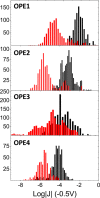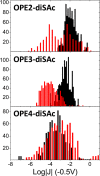Pronounced Environmental Effects on Injection Currents in EGaIn Tunneling Junctions Comprising Self-Assembled Monolayers
- PMID: 27738488
- PMCID: PMC5053169
- DOI: 10.1021/acs.jpcc.6b07089
Pronounced Environmental Effects on Injection Currents in EGaIn Tunneling Junctions Comprising Self-Assembled Monolayers
Abstract
Large-area tunneling junctions using eutectic Ga-In (EGaIn) as a top contact have proven to be a robust, reproducible, and technologically relevant platform for molecular electronics. Thus far, the majority of studies have focused on saturated molecules with backbones consisting mainly of alkanes in which the frontier orbitals are either highly localized or energetically inaccessible. We show that self-assembled monolayers of wire-like oligophenyleneethynylenes (OPEs), which are fully conjugated, only exhibit length-dependent tunneling behavior in a low-O2 environment. We attribute this unexpected behavior to the sensitivity of injection current on environment. We conclude that, contrary to previous reports, the self-limiting layer of Ga2O3 strongly influences transport properties and that the effect is related to the wetting behavior of the electrode. This result sheds light on the nature of the electrode-molecule interface and suggests that adhesive forces play a significant role in tunneling charge-transport in large-area molecular junctions.
Conflict of interest statement
The authors declare no competing financial interest.
Figures








References
-
- Khan M. R.; Trlica C.; Dickey M. D. Recapillarity: Electrochemically Controlled Capillary Withdrawal of a Liquid Metal Alloy From Microchannels. Adv. Funct. Mater. 2015, 25, 671–678. 10.1002/adfm.201403042. - DOI
-
- Wu Z.; Hjort K.; Jeong S. H. Microfluidic Stretchable Radio-Frequency Devices. Proc. IEEE 2015, 103, 1211–1225. 10.1109/JPROC.2015.2395716. - DOI
-
- Cademartiri L.; Thuo M. M.; Nijhuis C. A.; Reus W. F.; Tricard S.; Barber J. R.; Sodhi R. N. S.; Brodersen P.; Kim C.; Chiechi R. C.; et al. Electrical Resistance of AgTS–S(CH2)N–1CH3//Ga2O3/EGaIn Tunneling Junctions. J. Phys. Chem. C 2012, 116, 10848–10860. 10.1021/jp212501s. - DOI
LinkOut - more resources
Full Text Sources
Other Literature Sources
